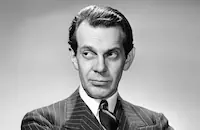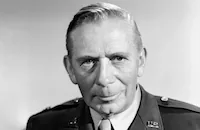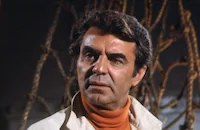The Desert Song

Brief Synopsis
Cast & Crew
Bruce Humberstone
Kathryn Grayson
Gordon Macrae
Steve Cochran
Raymond Massey
Dick Wesson
Film Details
Technical Specs

Synopsis
In Morocco, a band of Riffs successfully attack a caravan of Arabs carrying supplies to the most powerful man in the area, Sheik Yousseff, despite the escort provided by French Legionnaires under Capt. Claud Fontaine. After reclaiming food and supplies that Yousseff's men stole from their villages, the Riffs's leader, El Khobar, orders that they leave behind the Legionnaires' machine guns. However, the Arab Lachmed, who is employed by Yousseff, hides the guns, pretending they were taken by the Riffs, and gives them to Yousseff for later use. At his palace, Yousseff, who is feigning friendship with the French until he can drive them out, plans to dishonor El Khobar by having his men, disguised as Riffs, attack villages. Meanwhile, El Khobar takes leave of a small desert village, promising to return when needed. Margot Birabeau, who has escaped from her Paris school and longs for adventure, shows up at the Legion headquarters in the city of Djiba. When her father, Gen. Birabeau, arrives from Paris to check up on reports of dissidence, he decides that his feisty and love-hungry daughter is better off under his watchful eye and arranges for her to be tutored by shy Paul Bonnard, who is a student of anthropology studying native tribes. Overhearing Fontaine urge Birabeau to arm Yousseff against the Riffs, Bonnard interrupts, saying that the Riffs are only protecting themselves against Yousseff's plundering. Meanwhile, sparks fly between the ambitious Fontaine and Margot, who admires adventurous men, but she notices that her father is swayed by Bonnard's argument. The next day, Bonnard cancels Margot's lessons upon hearing a musical phrase repeatedly played by street musicians. This causes his American roommate, Benjy Kidd, who is a resourceful and often annoying newspaper reporter, to wonder about Bonnard's frequent changes of plan. Later, in a desert village, El Khobar shows up, having been summoned by the village leader Hassan, who is concerned that his neighbor Mindar is stirring up the people against Birabeau. El Khobar tells the people that Birabeau, whom he considers a discerning man, may be their salvation, but Mindar attacks him. Although, Mindar is taken to die in the desert on Hassan's orders, El Khobar later rescues him and sends him to Tunis. El Khobar's generosity is witnessed by a village girl, Azuri, whose passion he does not return. Having taken a job as a dancing girl at Yousseff's palace, Azuri has learned that Birabeau, Margot and Fontaine have been invited there. At the palace, Margot undiplomatically baits Yousseff with information she has learned from Bonnard, so Birabeau sends her to the palace garden. Benjy, who is also at the palace looking for a story, dons the veils of a harem girl and enters their private compartment, where he spies weapons, ammunition and a large army in a nearby room. Azuri helps him to safety through a secret palace entrance before Benjy is caught. Bonnard also shows up, but seeing Margot in the moonlight, changes into his alter ego, El Khobar, and romances her. She flirts with him until the palace is attacked by Yousseff's men dressed as Riffs. Believing Fontaine when he tells her that the Riffs are after her father, Margot reveals that El Khobar is in the garden. After eluding Fontaine, El Khobar abducts Margot and takes her to Hassan's village, where he hopes she will see the truth about Yousseff's duplicity. At first, she is a difficult guest, but after witnessing the arrival of Yousseff's victims, whose village was burned down, she again warms toward El Khobar. After returning to Djiba, Bonnard comforts Birabeau with news of Margot's well-being and convinces him to return with him to talk to the villagers. Meanwhile, Mindar has doubled back and joined Yousseff's men, leading them to Hassan's village. When Bonnard and Birabeau arrive, they find Hassan dying, the village in disarray and Margot kidnapped. Birabeau rides away alone, uncertain of Bonnard's integrity, and meets with Fontaine and his men, who have followed. Benjy has also tracked Bonnard to the village and after discovering his roommate's secret life, dresses as El Khobar and leads the Frenchmen on a chase, which allows Bonnard to leave the village unnoticed. After finding the Riffs, Bonnard, as El Khobar, directs them toward the palace, where Benjy, who has by now joined them, shows them the secret entrance. At the palace, Azuri realizes that Margot is in grave danger and is too heavily guarded to sneak out, so she goes for El Khobar, but runs into Benjy in the secret passageway. In the garden, a fight ensues between the Riffs and Yousseff's men. Spotting Margot with Yousseff, El Khobar rescues her with Benjy and Azuri's help. After arriving with the Legionnaires at the palace, Birabeau arrests Yousseff, whom he now realizes has been terrorizing the villagers with a well-supplied army. After the battle, El Khobar is discovered missing. When Bonnard replies that he is dead, Birabeau, who has deduced Bonnard's double life, reveals nothing. Margot, however, grieves and refuses Bonnard's efforts to console her, until he makes her see that he and El Khobar are "one alone."

Director

Bruce Humberstone
Cast

Kathryn Grayson

Gordon Macrae

Steve Cochran

Raymond Massey

Dick Wesson

Allyn Mclerie

Ray Collins

Paul Picerni

Frank De Kova

William Conrad
Trevor Bardette
Mark Dana
Julian Upton
Bhogwan Singh
Maurice Marsac
Joey Costarella
Ben Astar
Jack Reitzen
Harry Vejar
Sam Scar
Larry Chance
Harold Dyrenforth
Robert Hunter
Tom Hernandes
Enrico Alamiz
Paul Fierro
George Sawaya

Peter Brocco
Mack Thompson
Louis Lettieri
Robert Dane
Crew
Claude Archer
Gordon Bau
Marjorie Best
Robert Burks
Wilfrid M. Cline
Murray Cutter
Rudi Fehr
Stanley Fleischer
David Forrest
Jane Gorton
Oscar Hammerstein Ii
Chuck Hansen
Otto Harbach
D. R. O. Hatswell
Ray Heindorf
Elva Hill
Howard Hohler
Robert Hosler
Roland Kibbee
Mitchell G. Kovaleski
William L. Kuehl
Norman Luboff
Otis Malcolm
Norman Mcclay
Harold Noyes
Charles O'bannon
Herbert Plews
Leroy Prinz
Leah Rhodes
C. A. Riggs
Leon Roberts
Sigmund Romberg
Russell Saunders
Jack Scholl
William Schurr
Mario Silva
Joe Smith
Leonard South
Max Steiner
William A. Thompson
Serge Walter
Jack Woods
William Ziegler

Film Details
Technical Specs

Articles
The Desert Song (1953)
MacRae stars as a man with two lives, a mild-mannered anthropology student who doubles as a masked warrior leading the revolt against a tyrannical sheik (Raymond Massey). In his heroic guise, he wins the love of French general Ray Collins' temperamental daughter (Grayson), which creates complications. The film gave the leads a chance to do what they did best, which was more than just singing. MacRae had the build for swashbuckling roles and in The Desert Song he's presented as a kind of warbling Errol Flynn. And Grayson, whom Warner Bros. was wise to borrow from MGM, was always best in roles that allowed her to start haughty and then melt as she saw appealing aspects in her leading man. Always a better actress than most would credit, she knew how to act her songs and use them dramatically, even though MGM frequently hid her talents in overblown production numbers.
The original operetta was inspired by the 1925 uprising against French colonial rule in Morocco and T.E. Lawrence's World War I exploits, though politics took a back seat to one of Romberg's lushest scores, featuring such memorable numbers as "The Riff Song," "Romance" and "One Alone," with the latter becoming a popular choice for classical and jazz vocalists. It premiered in 1926 and played for over a year. Warner Bros. picked up the rights and filmed the story three times. In 1929, it was the first operetta filmed with sound, with Carlotta King and John Boles in the leading roles and Myrna Loy as an Arab dancing girl. That version also featured two-strip Technicolor scenes now only available in black and white. The 1943 version was re-crafted so that leading man Dennis Morgan could fight Nazis in support of the war effort. Irene Manning took over the female lead, with Faye Emerson as the dancing girl, all of it shot in glorious Technicolor.
By 1953, some things had changed and some things hadn't. Originally, the leading man's outlaw alter ego was named "The Red Shadow." That was changed in the second version to "El Khobar," and the change remained in the '50s because of the association of "red" with "Communist." But there were still few real Arabs in the cast, with the dancing girl now played by Allyn Ann McLerie, a Canadian-born singer and dancer who had come to the studio a year earlier to re-create her leading role opposite Ray Bolger in Where's Charley? (1952). The gay reporter who provides comic relief in the stage version was played straight in the film and allowed actor Dick Wesson to flirt with McLerie this time out. The biggest change, however, was in the leading man's motivation. On Broadway, The Red Shadow was leading the Riffs against the French colonial power and only backed off when a treaty was signed that met some of the Arabs' demands. By 1953, however, the Riffs were fighting against an evil sheik and eventually wound up defending colonial interests.
Warner Bros. entrusted the production to Rudi Fehr, a respected editor taking his only stab at production. He would return to editing afterwards, eventually winning his sole Oscar® nomination for John Huston's Prizzi's Honor (1985). The script was written by Roland Kibbee, who had just helped create a swashbuckling hit for Burt Lancaster in The Crimson Pirate (1952). Providing the production's high point for many was the work of Robert Burks, a cinematographer whose long association with Alfred Hitchcock would bring him an Oscar® for To Catch a Thief (1955). His Technicolor shots of the film's Yuma, Arizona, locations were consistently praised by critics. But after two versions of the operetta with strong direction (first by Roy Del Ruth; then by Robert Florey), the studio inexplicably entrusted the third to H. Bruce Humberstone. Although he had been working in Hollywood since the silent days, his strongest credits were as an assistant to such legends as King Vidor and Allan Dwan. His most notable accomplishment as a director on his own was discovering that the best way to get a performance out of Warner Oland in his Charlie Chan films at 20th Century-Fox during the 1930s was to keep the actor slightly drunk. Humberstone had only just arrived at Warner's, and his ability to get the Virginia Mayo-Ronald Reagan musical She's Working Her Way Through College (1952) completed efficiently and effectively may have been his chief recommendation for the job.
Most critics thought Warner's should have passed on a third version of The Desert Song. The New York Times praised the singing and the Technicolor location shooting, but had problems with the production as a whole, claiming it "batters the old war horse with such a wealth of dull, slipshod absurdities that, songs notwithstanding, the wonder now is how it ever got by in the first place." The film eventually was sold to television, but has rarely aired outside of the wee hours of the morning. The Desert Song itself has lived on. A version aired on live television in 1955 with Nelson Eddy in the lead. MacRae recorded the score twice, in a set of 78s in 1953 and later as a full recording for RCA with Dorothy Kirsten in 1963. For the 1987 centennial of Romberg's birth, the New York City Opera revived the operetta, with critics again extolling the score while lamenting the dated script.
Producer: Rudi Fehr
Director: H. Bruce Humberstone
Screenplay: Roland Kibbee
Based on an operetta by Sigmund Romberg, Laurence Schwab, Oscar Hammerstein II, Frank Mandel and Otto A. Harbach
Cinematography: Robert Burks
Art Director: Stanley Fleischer
Music: Max Steiner
Cast: Kathryn Grayson (Margot), Gordon MacRae (Paul Bonnard/El Khobar), Steve Cochran (Capt. Fontaine), Raymond Massey (Yousseff), Dick Wesson (Benjy Kidd), Allyn Ann McLerie (Azuri), Ray Collins (Gen. Birabeau), Paul Picerni (Hassan), Frank DeKova (Mindar), William Conrad (Lachmed).
C-111m.
by Frank Miller

The Desert Song (1953)
Quotes
It's you -- the one with the face!- Azuri
It's you --the one with the body!- Benjy
Trivia
Notes
A title card after the credits reads: "It is written in the burning sands of the Sahara: When there is wrong, there will always be an El Khobar, the Avenger, riding with his Riffs to right it...." Although actress Allyn McLerie was cast as the second female lead, an April 1952 Hollywood Reporter news item reported that Valerie Bettis also tested for the part. Kathryn Grayson was borrowed from M-G-M, according to an April 1952 Hollywood Reporter news item. Portions of the film were shot in Yuma, AZ, according to a May 1952 Hollywood Reporter news item. The same item reported that stunt man Joe Smith died during filming. The Desert Song marked Rudi Fehr's first film as producer. For information on two earlier adaptations of the 1926 musical play The Desert Song, both of which were produced by Warner Bros., see entries for the title in AFI Catalog of Feature Films, 1921-30 and AFI Catalog of Feature Films, 1941-50.

Miscellaneous Notes
Released in United States 1953
Released in United States 1953














